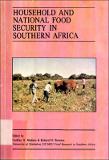| dc.contributor.author | Matiza, Tabeth | |
| dc.contributor.author | Zinyama, Lovemore M. | |
| dc.contributor.author | Campbell, David J. | |
| dc.coverage.spatial | Zimbabwe. | en |
| dc.date.accessioned | 2016-01-22T10:17:38Z | |
| dc.date.available | 2016-01-22T10:17:38Z | |
| dc.date.issued | 1988-10 | |
| dc.identifier.citation | Matiza, T., Zinyama, L.M. and Campbell, D. (1988) Household strategies for coping with food insecurity in low-rainfall areas of Zimbabwe. In: Mudimu, G.D. and Bernsten, R.H. (eds.) Household and national food security in Southern Africa, pp. 209-223. Harare: DAEE., | en |
| dc.identifier.uri | https://opendocs.ids.ac.uk/opendocs/handle/20.500.12413/7994 | |
| dc.description | A book chapter on strategies for coping with food insecurity in low-rainfall areas of Zimbabwe. | en |
| dc.description.abstract | Since the late 1960s, the countries of Sub-Saharan Africa have been struggling against severe food shortages and the crisis appears to be worsening rather than improving. A number of factors account for the continent’s growing inability to feed its rapidly expanding population. We have previously argued that one aspect of the food crisis that has received relatively little attention from policymakers is the role and status of local village-based strategies for coping with food deficits (Zinyama et al., 1987). It is at the level of the village that most food is produced and at which the majority of the African population seek security and protection against food shortages. When there is a food deficit, it tends to begin in villages and households that are most vulnerable and it frequently spreads over a wider geographical area. National and international concern is seldom raised until widespread hunger exists, by which time the villages and households initially affected may be in dire straits. It is now recognized that between the emergence of the problem and the arrival of external assistance, villages and farmers will employ a variety of strategies to mitigate the food shortage. In many cases, the strategies are sufficient to prevent famine and death and to reduce the need for external assistance. But in other cases, these village-based strategies are eventually overwhelmed by the magnitude of the crisis such that hunger, starvation and even death ensue. | en |
| dc.language.iso | en | en |
| dc.publisher | University of Zimbabwe (UZ) Publications/ Michigan State University (MSU) | en |
| dc.rights.uri | http://creativecommons.org/licenses/by-nc-nd/3.0/ | en |
| dc.subject | Agriculture | en |
| dc.subject | Poverty | en |
| dc.subject | Social Protection | en |
| dc.title | Household strategies for coping with food insecurity in low-rainfall areas of Zimbabwe | en |
| dc.type | Book chapter | en |
| dc.rights.holder | University of Zimbabwe (UZ)/ Michigan State University (MSU) | en |


